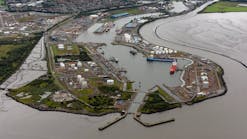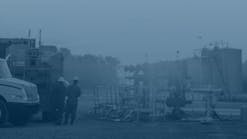Ian Frazer
Conoco (UK) Ltd.
Aberdeen
Michael W. Joosten, Erwin Buck, Juri Kolts
Conoco Inc.
Ponca City, Okla.
Glyn Jones
Conoco Inc.
Houston
A variety of corrosion-evaluation techniques applied to the 28-in., 86-mile Viking wet-gas line in the U.K. North Sea has shown the line to be essentially corrosion free after 18 years of service.
Internal corrosion rates over the period are estimated to be less than 0.05 mils per year (mpy).
Corrosion evaluation was based on data from iron counts, corrosion coupons, condensate and gas volumes, reservoir conditions, pipeline operating information, solids removal, ultrasonic surveys and field performance of the system.
VIKING FIELD, PIPELINES
The Viking gas field in the North Sea is served by facilities on two manned platform complexes, "A" and "B." A series of unmanned satellite platforms serves as gathering points to bring gas into the B complex for processing (Fig. 1).
The gas is transported through a 24-in. pipeline from the B to the A complex. Production at the A complex is added to that received from B.
Combined production is then transported through the 28-in., 86-mile trunk line to the Viking gas terminal at Theddlethorpe, Lincolnshire, U.K.
In 1972, Conoco initiated operation of a multiphase wet-gas pipeline in which fluids (condensed water and condensate) were intentionally transported with the gas. 1 2 Since the early introduction, multiphase pipelines have become more popular as an effective design philosophy for offshore development. 3 4
The main Viking 28-in. pipeline was designed to transport nearly 1 bscfd.
In the 28-in. pipeline, the CO2 content of the gas is approximately 0.5 mol % with inlet and outlet pressures of 1,450 and 1,150 psi, respectively. Typical water content is about 2 bbl/MMscf.
The pipeline is constructed of API 5LX X-60 steel with composition shown in Table 1 and was designed according to ANSI standards. It has a corrosion allowance of 10.9% of the nominal 0.688 in. W.T.
The steel conformed to the carbon equivalence indicated in the box below.
Operating conditions are represented by the typical winter and summer flow rates shown in Table 2.
The pipeline is sphered with a glycol-filled polyester bladder when gas flow rates fall to less than 550 MMscfd. Sphering is scheduled with only one sphere in the pipeline at a time.
The travel time for the sphere depends on the gas flow rate. At 200 MMscfd, for example, a sphere traverses the line in 24 hr.
The Viking pipeline has been treated with the inhibitor returns from production wells. The corrosion inhibitor, a polar organic compound of the filming amine type, is injected with methanol through downhole chemical injection valves at a concentration of approximately 0.2 pint/MMscf of gas produced.
Examples of water analyses of the pipeline are shown in Table 3.
For the purpose of metering and compression on the B platform, produced liquids are separated from the gas. After compression, the separated liquids (condensate, condensed water, produced water, and methanol-inhibitor) are reinjected into the gas stream.
Water produced on the A complex is separated and discharged. The gas condensate is separated from the gas but is reinjected into the pipeline.
PIPELINE EVALUATION
Assessing the condition of the Viking pipeline included examining historical data on iron counts, water analysis, theoretical water volumes, gas volumes, corrosion-coupon data on the platform and at the terminal, inlet and outlet temperatures, and pressures.
In addition, physical inspections of the pipeline's wall thicknesses were made in selected areas.
Flow regimes were also modeled to yield an understanding of the distribution of corrosion inhibitor in the pipeline.
Fluctuating gas demand produces a range of flow conditions in the pipeline. This variation and the introduction of spheres during low flow rates complicate the analysis of the pipeline flow.
A two-phase process flow model for determining the slug size for pipelines was used.
Historically, internal corrosion has not been of concern in the Viking pipeline system for reasons which include the following:
- Corrosion inhibitors are added to the entire system continually.
- Corrosion inhibitor residuals are measured in the condensed water at the terminal.
- Iron counts (and the corrosion rates calculated from iron counts) have been low and wells with high iron counts respond to inhibitor treatments.
- Corrosion coupon rates have been low.
- There have been no failures of flow lines.
- The amount of sludge brought to the terminal is low, implying low corrosion rates. Sludge that would require frequent removal would indicate much higher corrosion rates.
- Ultrasonic surveys of several risers and one 12-in. line, and two areas on the 28-in. line, have shown no wall thinning. Pitting has not been observed.
- Corrosion has not been found in sections of the pipeline removed from service. One riser and two sphere receivers have been removed.
IRON MASS BALANCE
Iron counts are highly effective for monitoring corrosion in the Viking pipeline system, where the corrosion products are soluble and the surface area of the line is large compared to the total water transported. The quantity of water being transported must be measured or accurately calculated.
Table 4 demonstrates the effectiveness of iron counts as a corrosion-monitoring tool. Notice that for wet-gas pipelines, the iron counts serve as an effective tool for monitoring.
In crude oil/water production, where the oil fraction is small (20% oil), or in oil or gas downhole tubulars where the surface area of the tubing is relatively small, iron counts are not as effective in corrosion monitoring.
Corrosion monitoring on the Viking system uses a total mass balance of iron in the system. Weekly water samples for iron counts are taken at each wellhead and pipeline outlet, and monthly averages are reported (Table 5).
Corrosion rates are calculated with the theoretical water dropout and assuming water saturation at reservoir conditions. The water dropout values have been verified on the Lincolnshire Offshore Gas Gathering System (Loggs) pipeline to be within a factor of two of the calculated volumes.
The iron count records have been maintained since the initial production began. The data indicate a corrosion rate of 0.006 mpy. The iron counts do not significantly differ from month to month.
Corrosion coupons are in the following locations:
- Viking gas terminal
- Methanol production line
- Methanol sea line
- Methanol still water leg
- Slug catcher
- "A" complex
- Two free-water separators
- Wellhead separator dump line
- Scrubber dump line
- "B" complex
- Scrubber dump line
- Wellhead separator dump line
- Eleven flow lines
- One liquid line.
The coupons were retrieved annually, although in some cases exposure time was 2 years. Coupons had corrosion rates of less than about 0.2 mpy; most were less than 0.06 in v. Such rates are at the limit of experimental sensitivity of the measurement technique.
The coupons at the slug catcher showed essentially zero corrosion. This coupon in the slug catcher is exposed to the same environment as the 28-in. pipeline.
SOLIDS CARRY-THROUGH
Very little sludge was produced in the pipeline system. Corrosion rates measured from iron counts would be in error if a significant fraction of the iron were carried as solids.
Analyses of sludge samples from the pipeline showed the presence of mill scale that is formed during steelmaking and sand (silica) debris from the wells. Mill scale has been found on internal sections of the sphere receiver even after 13 years' service. The solids in the slug catcher have been analyzed in the past and contained the following material: metallic iron, 26%; iron oxide, 31%; silica, 11%; NaCl, 19%; organics, 12.5%; and calcium, 0.5%.
The amount of sludge required significantly to influence the corrosion measurements would be enormous considering the length of the Viking pipeline. The slug catcher has never been cleaned; however, one holding tank had 50 bbl of solids removed a few years ago. And the slug catcher is only now reaching its capacity for solids.
If the Viking pipeline (not including satellite lines or equipment) were corroding at only 1 mpy, with the corrosion products retained as sludge, then each year an estimated 600 tons of solids would be generated. This amount of sludge would certainly be noticeable and require frequent cleaning of the slug catcher.
ULTRASONIC
MEASUREMENTS
Numerous automated ultrasonic wall thickness measurements have been made on various risers and pipelines in the Viking system. Some of these ultrasonic scans have been repeated after a couple of years to document the absence of corrosion.
Two systems have been utilized for the inspections: Ultra Image III ultrasonic imaging system (or updated version Q Scan) and the P-Scan Processor Mark III Corroscan Inspection System (PSP-3). The Ultra Image III system cannot inspect weld areas.
The PSP-3 system uses a focused transducer coupled through a water column. The method is much less sensitive to surface irregularities such as those associated with welds. Inspections 1, 2, and 3 were conducted with the Ultra Imaging system. Inspection 4 was conducted with the PSP-3. Inspection 5 used the Q Scan.
The inspections and areas of the Viking system inspected with these automated ultrasonic testing (UT) devices were the 24-in. gas riser, B.P. platform (summers 1985 and 1987), the 12-in. gas riser, B.D. platform (summers 1985 and 1987), the 12-in. E.D.-B.D. pipeline (summer 1988), the 28-in. A.R.-Mablethorpe pipeline (summers 1988 and 1990).
Results of all of the inspections have demonstrated that no corrosion had occurred in the system. All wall-thickness measurements were within the thickness tolerances of the original installed lines.
For example, inspection of the 24 and 12-in. gas risers showed that the corrosion rates were too low to be measured by the UT technique. The absence of corrosion was confirmed in a subsea inspection of the 12-in. 8-mile Viking E.D.-B.D. pipeline (Fig. 1) conducted with the underwater version of the Ultra Image UT equipment.
The line has 0.562 in. W.T. (-12.5/+15% tolerance) is made from X-60 grade steel and has been in service since Nov. 13, 1975. Three locations inspected represent the topography of the line: a straight section within a mile of the Viking E.D. platform, a downward sloping segment which drops about 15 ft over a run of approximately 600 ft, and a segment close to the crest of a long upward slope.
The scan area consisted of a region 2.5-3 in. wide which included the field weld.
A field joint 1 mile from the platform on the 28-in. Viking pipeline was inspected. The inspection consisted of a 9.5-in. scan on each side of the butt weld using P-Scan Processor Mark III Corroscan Inspection System (PSP-3). A focused transducer coupled through a water column allows the transducer to standoff from the surface of the pipe allowing inspection of the weld area.
The two scans found no evidence of pitting or general weight-loss corrosion on the internal pipeline surfaces. The mean wall thickness of the entire scan area was between 0.673 and 0.705 in. This is within the tolerances for the pipeline wall thickness as manufactured (0.633-0.819 in.). The nominal wall thickness is 0.688 in.
Finally, a subsea inspection was carried out in the summer of 1990. Modeling of the corrosion behavior of the pipeline was used to predict the most severe location of corrosion in the line.
Subsea inspection was carried out with the P-Scan system. Confirming the results of all previous examinations and corrosion monitoring information, no corrosion was found.
ACKNOWLEDGMENT
The authors wish to thank Conoco U.K. Ltd. and BP Exploration for permission to publish this article.
REFERENCES
- Frazer, I., Light, M. F., Foulds, N., and Jones, G. R., private communications, Conoco U.K. Ltd.
- King, W.R., and Taylor, F.R., "Field Evaluation of Corrosion Control Chemicals in the Viking Gas Field," SPE No. 5286, 1975.
- Guy, J.M., de Merville, E., and Bernicot, M., "Multiphase Pipe-line: A Solution to Cost Saving in Offshore Production," SPE No. 21100, 1990.
- Starsmore, R. P., "History of a Wet Gas Transportation Pipeline from Design Through to Decommissioning," Corrosion Prevention and Control, October 1990, p. 117.


